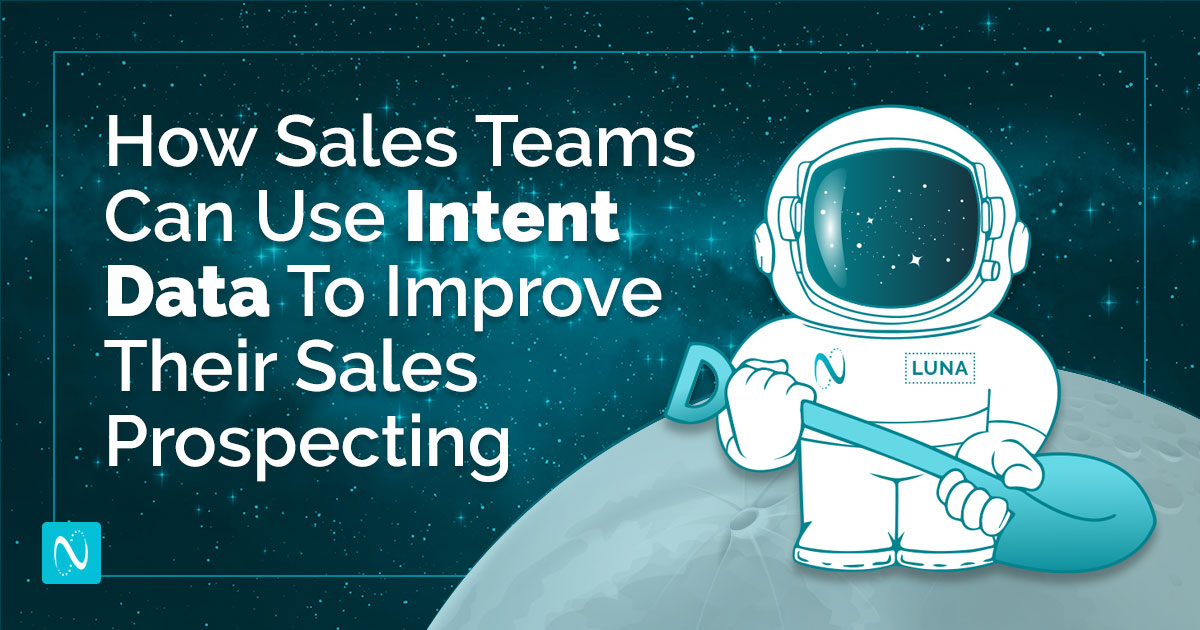Technology and data—specifically buyer-level intent data —take a lot of the guesswork out of sales prospecting, making it more precise.
Still, there are plenty of questions surrounding intent data.
How can intent data help sales teams identify high-potential prospects more effectively?
While there may be plenty of questions, only one is asked more often than others: How can our Sales team use it effectively?
Here’s how it is done:
- Identify actively researching prospects: When prospects are actively researching a product or service, they leave a trail of digital footprints.
Buyer-intent data captures these footprints (signals) and provides insight into the research buyers are doing and what their interests are. It tells you what buyers have been searching for, where they are searching, and why.
Oh, and most importantly, it tells you who is searching. These signals can help later on when your sales team approaches a potential buyer. It also indicates when a prospect is in the mindset to buy. - Segment prospects based on their level of intent: Not all prospects have the same likelihood of converting into customers.
Buyer-level intent data can be used to segment prospects into different categories, those who are probably just browsing and prospects showing strong signals of intent to buy — those who have done a lot of research and have spent a lot of time on your site and elsewhere exploring your product.
This sort of segementation enables you to prioritize outreach to high-intent prospects, saving time and effort.
- Identify potential influencers within the buying committee: It’s important to identify the individuals who have purchase influence within the buyer committee.
This way, Sales can approach those key individuals who are making the decisions and tailor their messaging and outreach for each decision-maker based on their position and the channels they show a preference in using.
What are the best practices for using intent data in sales prospecting efforts?
Now that you have a few simple steps to help your sales team effectively identify high-potential prospects, it’s a good time to take a look at some of the best practices to keep in mind when you are using intent data for sales prospecting.
The good news? You don’t have to start from scratch.
Integrating the process
Instead, if you want to get the most out of intent data, it should be seamlessly integrated into your existing sales prospecting processes. You aren’t reinventing the wheel when you add intent data into the mix, you’re just improving what is already there.
As an example, combining CRM data with intent data gives you a 360-degree perspective. Now, armed with vital information and context about the prospect, any cold calls are far less cold.
- You know who they are
- Where they’ve been searching
- And what problems they are trying to solve.
Now, when that call is made, sales can tailor their messaging around this information.
Gauging interest
Alongside integrating intent data into your existing sales processes, it’s essential to define clear parameters to gauge a prospect’s level of intent.
Criteria like content engagement, webinar registrations, and search queries can be vital indicators of a prospect’s position in the buyer journey.
With a well-defined framework, sales reps can focus their efforts on high-priority leads, increasing the efficiency of the overall prospecting process.
Timeliness
Intent data has a shelf-life.
The data that was pertinent six months ago, is likely to be far less on point today. Outdated data can lead to misguided efforts and wasted time and resources chasing a prospect that may have already solved their problems and are no longer in market.
Or maybe that decision-maker who was showing interest four months ago has since moved on to another company. Either way, pursuing a prospect on old data often equals a whole lot of frustration with little reward.
The best way to ensure that the intent data you are using is accurate and up-to-date is to use an intent data provider that makes this a priority.
How can intent data be used to create more targeted and relevant sales outreach?
Per a survey from Forrester and Adobe, the majority of B2B buyers have an expectation of personalization throughout their journey.
This is especially true towards the later stages of that journey, with two-thirds saying they expect fully personalized or mostly personalized content when buying a service or product.
Fortunately, not only does intent data aid sales prospecting by helping to identify those high-potential prospects we talked about earlier, but it also arms sales with the information they need to tailor personalized outreach.
Because sales have that vital information about where the prospect is looking and what they are researching, sales can design outreach that focuses on that buyer’s specific needs, making communication more impactful, which leads to more meaningful engagement.
The insights gained from intent data should be used to tailor the messaging and content of the sales outreach. Whether it’s the value proposition, product features, or case studies, every aspect of the sales message should resonate with the prospect’s unique needs and interests.
Timing plays a critical role in creating more targeted and relevant outreach as well. Hitting that sweet spot between approaching a prospect too early and too late can be tricky business.
However, intent data can help determine the optimal time to contact a prospect, ensuring that your sales team is reaching out when the prospect when the iron is hot and is most respective.
Bonus: How to Use Tailored Messaging Strategies
To address the challenge of creating personalized messages that speak directly to the prospect’s needs, organizations can:
- Implement Regular Training and Workshops: These sessions should educate sales teams on how to use intent data to understand buyer personas and craft messages that align with the prospect’s current stage and needs.
- Develop Content Libraries: Create resources including email templates and call scripts that are aligned with different stages of the buyer’s journey and tailored to specific buyer personas.
- Utilize AI and Automation Tools: Leverage advanced tools to automate parts of the messaging process, ensuring consistency and personalization at scale.
How can intent data be used to improve the sales prospecting process overall?
When used correctly, buyer-level intent data obtained from a reliable source can bring transformative improvements to your sales prospecting process. It can work to align sales and marketing teams, identify gaps in your sales funnel and help to optimize sales efforts. Let’s look at these individually.
Aligning sales and marketing teams
We’ve covered the importance of aligning sales and marketing teams several times.
Collaboration and alignment between these two teams are vital to the success of any campaign. And, for many, intent data is the key to bringing about this alignment.
Research from Ascend2 found that aligning sales and marketing was one of the primary goals of using intent data for 45% of B2B and B2C marketing professionals surveyed.
This alignment is possible when marketing and sales operate in unison and create a shared understanding of what signals they need to look for in intent data so that they attract, nurture. and approach the right prospects at the right time in their buyer’s journey.
Identifying Gaps in the Sales Funnel
Intent data can uncover areas in your sales funnel where prospects are falling out. By identifying the gaps and understanding where prospects drop out or lose interest you can implement strategies to plug them.
Plugging the gaps may involve looking at the content you have available at that stage. Maybe it doesn’t answer the questions prospects have at that stage. Or perhaps it’s the wrong type of content altogether.
Either way, knowing where the gaps are enables you to make targeted adjustments to keep prospects engaged when they are faltering, improving overall pipeline health.
Continuously Measuring and Optimizing
Sales prospecting is far from a set-and-forget endeavor, Just like other sales and marketing processes, your sales prospecting needs to be constantly evaluated to gauge the effectiveness of your strategies.
Intent data should be used during the evaluation process as it can provide invaluable metrics to assess the efficacy of your outreach and help you refine and optimize your sales processes and strategies over time.
Unleashing The Power of Precision Prospecting
Buyer-level intent data provides invaluable insights for sales teams aiming to enhance their prospecting efforts. Intent data can significantly improve sales by identifying high-potential prospects, enabling targeted outreach, and facilitating continuous optimization.
Take the leap into the future of sales prospecting. Reap the rewards of precision, effectiveness, and efficiency with intent data.



